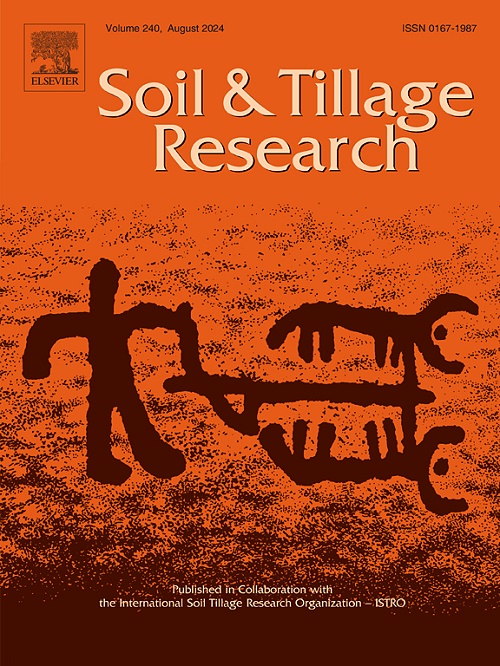Soil surface properties and infiltration response to crust forming of a sandy loam and silt loam
IF 6.1
1区 农林科学
Q1 SOIL SCIENCE
引用次数: 0
Abstract
Soil surface crusting is a common phenomenon on agricultural soils susceptible to raindrop impact. Crusts affect soil hydrological properties, erosion, crop quality and yield, which implicates both agriculture and the environment. While methods for determining hydraulic or basic properties of thick soil layers are well established, measuring the soil characteristics of a thin crust still remains a challenge. In this study, we combined traditional lab methods and advanced techniques to reveal temporal variations of crust micro-morphology and their effect on soil properties with cumulative rainfall. Composite samples from two soil textures, a sandy loam and a silt loam, were collected and packed in soil pans, and exposed to a range of rainfall amounts and two rainfall intensities, using a laboratory nozzle-type rainulator. Intact soil ring samples were collected after each rainfall event. They were scanned using X-ray micro-computed Tomography (CT) to determine the evolution of soil porosity, bulk density and crust thickness during the crust formation process. The water permeability and infiltration dynamics of the developing crusts were investigated with minidisk infiltrometers placed on the crusts developed in the pans. Shear strength was evaluated by a hand vane. Disturbed soil was collected to explore variation in organic matter content and texture with cumulative rainfall. During the simulated rainfall events, soil loss, splash and runoff were recorded as well. We found that runoff volume and sediment mass increased, while splash and infiltration volume decreased with increasing rainfall amount. Shear strength increased until 200 mm of rainfall. Rainfall that resulted in crust formation had a rapid and strong effect on the hydraulic properties, with the unsaturated hydraulic conductivity being reduced as rainfall duration increased, and with high rainfall intensity having a greater impact than the low intensity. This was associated with rainfall-induced aggregate breakdown processes, which was confirmed by micro-CT. From the micro-CT images, we found that porosity reached a minimum value after 50 mm rainfall, while bulk density reached a maximum value. The dense crust was then partially removed/dissolved by further rainfall events. Crust thicknesses were about 3.19 and 4.85 mm, and the mean porosity of the crust layers was about 24 % and 27 % smaller than that of the underlying layer, at relatively high and low rainfall intensity, respectively. In conclusion, rainfall events significantly affect crust formation, on which the early-stage has the greatest influence. The crusts are rapidly formed under high rainfall intensity, but a thicker crust is formed under a longer duration of low rainfall intensity. The thickness of the crust increases with increasing rainfall, but its porosity does not decrease correspondingly.
砂质壤土和粉质壤土土壤表面特性及入渗对结皮的响应
土壤表层结皮是农业土壤易受雨滴冲击的常见现象。结皮影响土壤水文特性、侵蚀、作物质量和产量,涉及农业和环境。虽然确定厚土层水力或基本特性的方法已经建立,但测量薄地壳的土壤特性仍然是一个挑战。本研究将传统的实验室方法与先进的技术相结合,揭示了累积降雨量下地壳微形态的时间变化及其对土壤性质的影响。收集砂质壤土和粉质壤土两种土壤质地的复合样品,并将其包装在土盘中,使用实验室喷嘴式降雨器暴露在一系列降雨量和两种降雨强度下。每次降雨后采集完整的土壤环样。利用x射线微计算机断层扫描(CT)对其进行扫描,以确定地壳形成过程中土壤孔隙度、容重和地壳厚度的演变。利用微型盘式渗透仪对发育中的地壳的透水性和入渗动力学进行了研究。抗剪强度用手摇叶片进行评估。采集扰动土壤,探讨土壤有机质含量和质地随累积降雨量的变化。在模拟降雨过程中,还记录了土壤流失、飞溅和径流。径流量和沙质随降雨量的增加而增加,而溅射量和入渗量随降雨量的增加而减少。抗剪强度增加至200 mm雨量。导致地壳形成的降雨对水力学性能的影响迅速而强烈,随着降雨持续时间的增加,非饱和导电性降低,且高降雨强度比低降雨强度的影响更大。这与降雨引起的团聚体破裂过程有关,这一点经微ct证实。从显微ct图像中,我们发现孔隙度在50 mm降雨后达到最小值,而容重达到最大值。致密的地壳随后被进一步的降雨事件部分移除/溶解。在较高和较低降雨强度下,地壳厚度分别约为3.19和4.85 mm,地壳层的平均孔隙率分别比下垫层小24 %和27 %。综上所述,降雨事件对地壳形成有显著影响,其中早期对地壳形成的影响最大。强降雨条件下地壳形成迅速,弱降雨条件下地壳形成较厚。地壳厚度随降雨量的增加而增加,但孔隙度没有相应减少。
本文章由计算机程序翻译,如有差异,请以英文原文为准。
求助全文
约1分钟内获得全文
求助全文
来源期刊

Soil & Tillage Research
农林科学-土壤科学
CiteScore
13.00
自引率
6.20%
发文量
266
审稿时长
5 months
期刊介绍:
Soil & Tillage Research examines the physical, chemical and biological changes in the soil caused by tillage and field traffic. Manuscripts will be considered on aspects of soil science, physics, technology, mechanization and applied engineering for a sustainable balance among productivity, environmental quality and profitability. The following are examples of suitable topics within the scope of the journal of Soil and Tillage Research:
The agricultural and biosystems engineering associated with tillage (including no-tillage, reduced-tillage and direct drilling), irrigation and drainage, crops and crop rotations, fertilization, rehabilitation of mine spoils and processes used to modify soils. Soil change effects on establishment and yield of crops, growth of plants and roots, structure and erosion of soil, cycling of carbon and nutrients, greenhouse gas emissions, leaching, runoff and other processes that affect environmental quality. Characterization or modeling of tillage and field traffic responses, soil, climate, or topographic effects, soil deformation processes, tillage tools, traction devices, energy requirements, economics, surface and subsurface water quality effects, tillage effects on weed, pest and disease control, and their interactions.
 求助内容:
求助内容: 应助结果提醒方式:
应助结果提醒方式:


